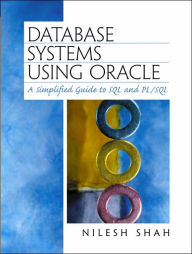
Database Systems Using Oracle: A Simplified Guide to SQL and PL/SQL / Edition 1
by Nilesh D. ShahISBN-10: 0130909335
ISBN-13: 9780130909336
Pub. Date: 07/10/2001
Publisher: Prentice Hall
Overview
Oracle is the premier database package used in industry and it is the preferred choice of many academic institutions to teach relational database applications. Database Systems Using Oracle provides the most comprehensive coverage of the Structured Query Language (SQL) and the Programming Language/ Structured Query Language (PUSQL) in Oracle version 8 or higher.
Mastery of Oracle SQL and PUSQL languages is greatly facilitated by the provision of clear, step-by-step instructions, supplemented by hands-on examples, exercise questions, and lab activities. Throughout the text the author uses two real-life running databases as a model as well as a dedicated section on SQL statements with an additional third database scenario. Exposure to these databases increases comprehension of real-life database issues.
Features:
- Comprehensive coverage of the relational concepts and the database designing techniques necessary to design and implement effective database systems.
- Thorough coverage of SQL.
- Complete coverage of PL/SQL.
- An introduction to the architecture and administration of Oracle 8, Oracle 8I, and the concept of object orientation.
- Each chapter contains many exercise questions and lab activities promoting the "learn-by-doing" approach.
- A companion website offers instant student assessment materials and PowerPoint slides for each chapter.
Product Details
- ISBN-13:
- 9780130909336
- Publisher:
- Prentice Hall
- Publication date:
- 07/10/2001
- Edition description:
- Older Edition
- Pages:
- 326
- Product dimensions:
- 6.90(w) x 9.30(h) x 0.52(d)
Table of Contents
Most chapters end with In a Nutshell, Exercise Questions, and a Lab Activity.
I. DATABASE CONCEPTS.
2. Database Design: Data Modeling and Normalization.
II. THE ORACLE SQL.
4. Oracle Tables: Creation and Modification.
5. Working with Tables: Data Management and Retrieval.
6. Multiple Tables: Joins and Sub-Queries.
7. Advanced Features: Objects, Transactions, and Control.
III. PL/SQL.
9. SQL and Control Structures in PL/SQL.
10. Cursors and Exceptions.
11. Composite Data Types: Records and Tables.
12. Procedures, Functions and Packages.
IV. MISCELLANEOUS TOPICS.
14. Oracle 8i: An Overview and Web Tools.
Appendix A: Sample Databases: Table Definitions.
Appendix B: Quick Reference to SQL & PL/SQL Syntax.
Appendix C: Additional References.
Index.
Customer Reviews
Average Review: